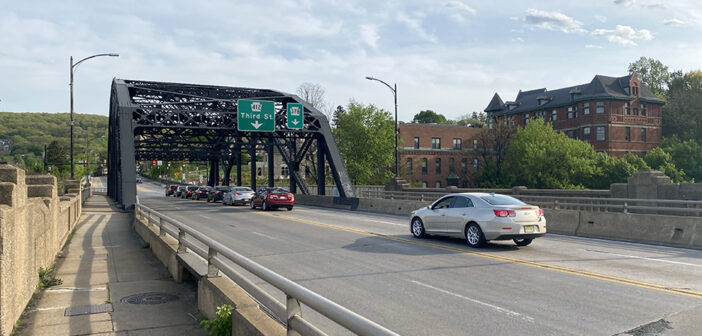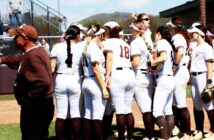The Pennsylvania Department of Transportation is planning to fix the state Route 378 Hill-to-Hill Bridge and encourages the public to offer comments, questions or concerns about the project display. The project plans display is open to community input until May 7, and is viewable online due to the governor’s COVID-19 policies.
PennDOT has started to plan and design what repairs will be made to the historic state bridge, which supports about 55,000 vehicles daily. The Hill-to-Hill Bridge is nearly a century old and has 13 spans that cross the Lehigh River, Sand Island Park, the D&L Canal Trail and many rail lines.
Bethlehem director of public works and city engineer Michael Alkhal said the Hill-to-Hill Bridge is one of three main access points across the Lehigh River. He said the city and state have been working closely together, and that they need to address not only the bridge’s needed repairs but also capacity issues.
He has observed significant queuing and delays accessing the bridge from the Second Street Ramp among other movements, and thinks travel lanes should be widened. According to Alkhal, the city wants to create more access to the Second Street Ramp from Second Street and improve accommodations and safety for pedestrians with widened sidewalks.
“Structurally, the bridge needs some major rehab,” Alkhal said. “It’s a key structure that carries a lot of traffic. These types of structures get annually inspected, and when there are issues they get addressed. And at some point, it gets to the point that they need major rehab or replacement. This one is due for that.”
Alkhal added that it is critical that traffic accessing the hospital be maintained during construction, so the planning process also takes this into consideration.
District Press Officer Ronald J. Young said he recognizes that the bridge is a major conduit not just for automobiles, but also for bicyclists and pedestrians. Young is involved in the public communication aspect of the project plans, so he takes Bethlehem residents into account as the Hill-to-Hill Bridge rehabilitation plans continue.
“Pre-pandemic, you’d get literally thousands of people a day coming to and from the Wind Creek Casino, Lehigh University as well as other things offered in the city of Bethlehem,” Young said. “It’s a major area for people who work at the hospital, at the university, at the casino and several other businesses in the area who use this roadway.”
Young aims to ensure that the technical plans are presented in a way that is comprehensible to the public for full understanding. According to Young, the hope would be to start construction in 2024 if all plans are approved.
“We want people to take a look at it, review it, and if they see anything that they think we missed, let us know. If they see things they like, let us know. If there are things they don’t like and maybe should be modified or eliminated, let us know, as well,” Young said.
Design Services engineer David Rostron is part of the team that does most of the engineering work, according to Young.
Rostron describes his role as a “higher level reviewer” who reviews many submissions in the design process. He also oversees all environmental aspects of project plans. Rostron said maintaining traffic is crucial for a project that is set to take years, but PennDOT has made it a project goal to maintain two-way traffic as much as possible during the bridge rehabilitation.
“One of the decisions that’s made early on in these projects is looking at what do we need to maintain the existing traffic, especially with this being a higher-level road that definitely needs to be kept open as much as possible,” Rostron said. “Ultimately, you have to do some closures at times to get something done, especially with the structure involved, but we will try to keep those off peak time frames. Late night or over the weekend.”
Rostron also values public input, as civilians are impacted if they rely on the bridge daily.
“Some of us don’t live there every day, so it’s definitely important to get any input from anyone who is more affected by what we’re going to do,” Rostron said.
It is also legally required for the community to have the opportunity to provide feedback on these types of projects and have access to and the space to voice opinions on any project plans to this scale.
“Public comment is an important component of these types of projects,” Alkhal said. “And rightfully so. The purpose of that is for the public to have an opportunity to provide feedback, of course these projects are funded by the public.”






Comment policy
Comments posted to The Brown and White website are reviewed by a moderator before being approved. Incendiary speech or harassing language, including comments targeted at individuals, may be deemed unacceptable and not published. Spam and other soliciting will also be declined.
The Brown and White also reserves the right to not publish entirely anonymous comments.
1 Comment
The ‘Hill to Hill bridge’, as it has come to be colloquially known, is a solid, impressive edifice no doubt constructed with the help and employ of Bethlehem Steel when the latter was operating at full bore in the early 20th century. As a student, I remember the bridge feeling so solid travelling over it, it was as if it were a part of the landscape.
I attended Lehigh during the 1980s when Bethlehem Steel had slowed down, and the town itself had become seriously depressed. Lehigh Un. was slowly evolving into being the largest employer in town. Beth Steel’s nighttime violet flames were nevertheless still active and visible over the company’s great works.. But cheap steel was continuously being imported into America, and in vast quantities, as President R. Reagan was a firm believer in free trade. This really hurt Steel as the latter had just spent the last half century attending to worker’s rights and safety. The steel workers had now come to be very well paid, but this long and arduous process had duly increased the price of finished steel and to a point were many American companies could no longer compete.
I see this bridge as being therefore symbolical of the company Bethlehem Steel, and so feel it would be unfortunate if it were torn down and replaced with a cheap later 20th/ early 21st century bridge such as the other two bridges are. I’m sure the issues with the Hill to Hill bridge more so involve problems of flow and access and not that the bridge itself is structurally compromised. So perhaps a second floor could be added to it, such as with New York’s famous George Washington (and concerning which steel from Bethlehem was used) …? Or might it be possible to extend it laterally so as to add lanes? Or construct a second complementary and accessorial bridge that would operate in conjunction with it? It would be unfortunate to lose the original bridge,.